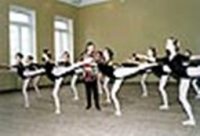Perm Ballet school
The front view of the building
The History of Perm Ballet School
The school roots were set during the World War II , when the Kirov Company and its school were evacuated from Leningrad to Perm. On the 6th of July in 1942 the first concert performance by the students of the Leningrad Academy took place at the Perm Theatre stage. They performed a divertisment and the master-class was given by the renowned Agrippina Vaganova. During the War years the stars of the future – Ninel Kurgapkina, Irina Kolpakova, Nikolai Boyarchikov, Yuri Grigorovich and many others, would all be trained in Perm. On the 7th of February in 1943 the first enrollment of the local children took place. This heralded the beginning of what has now become one of the most prestigious ballet Academies in Russia. In 1994 the Kirov Company and the Ballet school returned home to the city on the Neva. The seeds were already sown and flourished. Many members of the Vaganova school, headed by Ekaterina Heidenreich, decided to continue their work in the city. It was she, who became Perm school’s first artistic director. At the school’s opening concert her pupils demonstrated a number of ballet enchantments, as well as numerous folk dances. In spring in 1946 the school premiered its first big performance: the ballet “Repka”. In May of 1950 the first eleven students graduated from the academy. Among them there was Marianna Podkina, who would later become the first People’s Artist in the history of the Perm school. Soon afterwards the country’s choreographic schools competed in Moscow. Perm took the third place after Moscow and Leningrad. Since then teaching standards of excellence and Perm State Academy are synonymous.
The schools own repertoire would go on to grow in the coming years: 1955 – P. Tchaikovskiy “The Nutracker”, staged by K. Esaulova.
Щелкунчик
1957 – G. Terpilovsky “Chudesnitza”, a one-act ballet staged by K. Esaulova.
1960 – D. Delibe “Coppelia”, staged by G. Shishkin.
1962 – G. Zorin “Luybka”, staged by G. Shishkin.
1968 – B. Trotzuk “White Dove”, staged by S. Burkhanov.
1973 – F. Chopin “Chopeniana”, after F. Fokine’s version.
1974 – Act 2 from A. Adam’s “Gisselle”.
1968 – Class concert in L. Sakharova’s choreography.
1989 – I. Morozov “Doctor Doolittle”, staged by E. Serezhnikova.
1994 – P. Tchaikovskiy “The Nutracker”, L. Sakharova’s version.
Among the recent premieres there is “Choreographic Fantasies” to Hydn’s music (symphony 104) and Glinka’s “Waltz-Fantasy”, choreographed by Georgy Aleksidze. In 2000 in Oxford, at the festival “Communication through arts”, the Perm school participated in the international premiere of B. Britten’s opera “Noah’s Ark”. The opera’s scene “Storm”, choreographed by Perm ballet master Evgeny Panfilov, was acclaimed by the critics as one of the brightest. Among the most recent choreographies is P. Sheshukov’s number to Hydn’s music and “Spanish Tunes”, staged by Elena Kamenskaya, a school teacher.
Teacher’s staff
The school’s teaching staff features 60 members, more than 20 of them are ballet coaches. One of the most experienced teachers for ballet is Ninel Danilovna Silvanovich who had worked more than 45 years with the school and nurtured many generations of dancers. Many of the teachers are former school graduates and company dancers. The school entered a new phase upon the arrival of Ludmila Pavlovna Sakharovna in 1967 and is still under her direction. A graduate of the Bolshoi, she brought together two traditions of ballet training.
Graduates of Perm Ballet School
Academy students have performed in many countries – Shri-Lanka, England, Bulgaria, Mexico, China, America, Japan, Germany and Israel. Graduates have also joined leading dance companies in Russia and abroad.
Former school graduates now teach at many professional and amateur dance companies: Sergei Alexsandrov in Brazil, Natalia Guseva and Marce Mirgaripov in China, Marat Daukaev and Evgeny Katusov in America, Vladimir Tolstukhin in Turkey. Lidia Ulanova and Elena Bystrtskaya worked in Ireland and came back to work at their home school again. Coming back is always good, because, as they say, “east or west, home is best”. It is more interesting to work at home, for ballet in Russia means not only a profession, but a way of life.
Lyubov Kunakova, Olga Chenchicova, Marat Daukaev went on to become stars for the selebrated Mariinsky and Nadezhda Pavlova – a Prima Ballerina with the Bolshoi. Still many more have confirmed the excellence of this schooling: Galina Shlyapina , Svetlana Smirnova, Victor Baranov, Yuri Petukhov, Ludmila Shipulina, Regina Kuzmitchova, Natalia Balakhnitchova and many, many others. Among them there is Vadim Muntagirov. In January of 2006, Vadim won the President's Prize at the Prix de Lausanne, Europe's premier competition for young dancers. In March he then won First Prize in the Kazan International Ballet Competition, and in April he won Second Prize at the Perm International Ballet Competition (the soloist winning first prize being nearly a decade his senior). In June of that same year, Vadim won the Grand Prize at the St. Petersburg International Ballet Competition, where he also received the title "Hope of Russia" from the jury chaired by Natalya Makarova.
(From the book: Tatyana Chernova. The birth of a swan. Perm, "Пермская книга", 2001)
Пермское хореографическое училище
Location:
N 58°00°58°01 E 56°15°01.69 Google Earth

